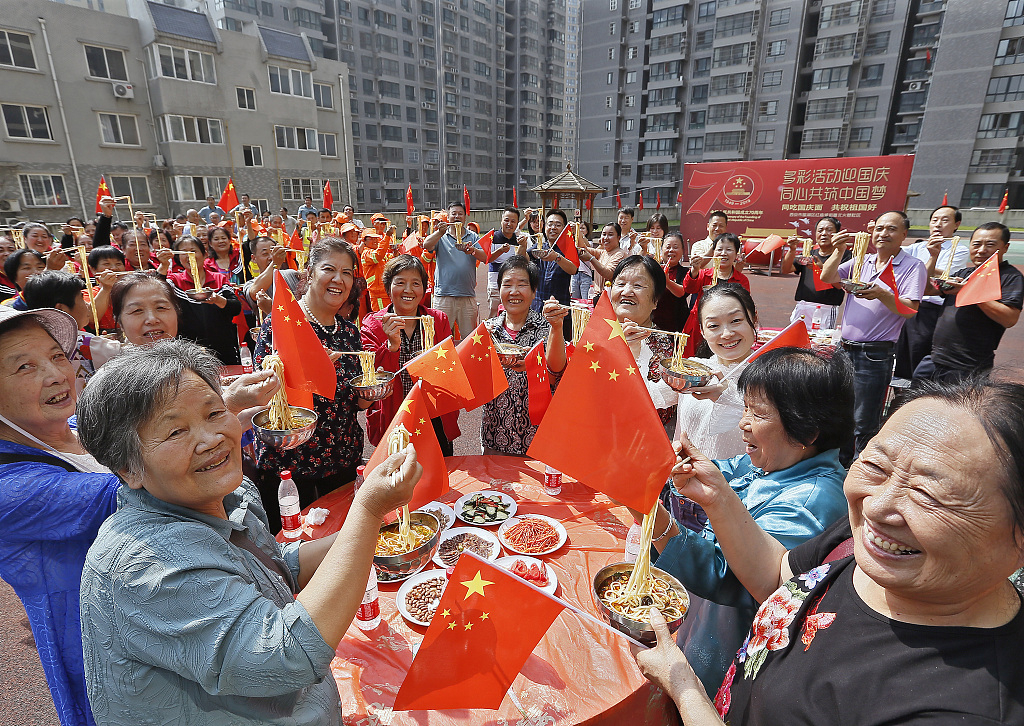
Thousands of Chinese musicians, dancers and opera singers come together to celebrate the 70th anniversary of the People's Republic of China at the National Day parade in Beijing, China, October 1, 2019. /CGTN Gif
Thousands of Chinese musicians, dancers and opera singers come together to celebrate the 70th anniversary of the People's Republic of China at the National Day parade in Beijing, China, October 1, 2019. /CGTN Gif
Thousands of Chinese musicians, dancers and opera singers came together to celebrate the 70th anniversary of the People's Republic of China at the National Day parade on Tuesday, showcasing the nation's 5,000-year-old, rich and diverse culture and its people's happy lives.
China has seen its cultural treasures and abundant multi-ethnic legacy flourish over the past seven decades.
The Chinese government attaches great importance to protecting cultural sites and relics, implementing numerous policies and regulations to revitalize traditional Chinese culture.

Foreign journalists watch Chinese Opera at the Lao She Teahouse during the Forum on China-Africa Cooperation in Beijing, China, August 30, 2018. /VCG Photo
Foreign journalists watch Chinese Opera at the Lao She Teahouse during the Forum on China-Africa Cooperation in Beijing, China, August 30, 2018. /VCG Photo
An intangible cultural heritage protection network has been set up nationwide, comprising 2,467 institutions and 17,308 personnel as of the end of 2018, according to a report by the Ministry of Culture and Tourism.
These institutions sponsored about 65,500 performances and over 16,800 cultural activities in 2018, attracting audiences of 98 million, said the official report.
Read more:
China builds intangible cultural heritage protection network
Museums need diverse services, cultural relics call for 'last-mile' protection
Rule on 'state reserves of cultural ecology' takes effect

A formation of teachers and students included college students from universities across Beijing. The group waved colorful school flags, at the National Day parade in Beijing, China, October 1, 2019. /CGTN Gif
A formation of teachers and students included college students from universities across Beijing. The group waved colorful school flags, at the National Day parade in Beijing, China, October 1, 2019. /CGTN Gif
A float decorated with books and a tree of knowledge was accompanied by a formation of teachers and students, including college students from universities across Beijing, who waved colorful school flags.
China strives for improvement in the quality of its education, and is looking to enable every child to enjoy fairer education through more investment and reforms.
According to data released by the Ministry of Education in 2019, China spent more than 4.6 trillion yuan (about 685 billion U.S. dollars) on education nationwide, up 8.39 percent year on year.

Students taking a training course in robotics in Hefei, Anhui, China, March 19, 2019. /VCG Photo
Students taking a training course in robotics in Hefei, Anhui, China, March 19, 2019. /VCG Photo
Government budgetary spending on education amounted to over 3.6 trillion yuan, up 8.13 percent year on year.
As the nation goes digital in education, quality educational resources that were once unique to developed urban regions are rapidly extending to classrooms in frontier and rural areas.
The proportion of primary and high schools that have access to the internet has grown from 25 percent to 96 percent since late 2012.
Nearly 100 million rural Chinese students in primary and middle schools are covered by a national satellite broadband transmission network for online education.
Read more:
Premier: China to provide more equitable, higher-quality education
China issues blueprint on modernization of education
Why China can give every child equal access to education?

The remarkable development of all aspects of Chinese people's daily lives was displayed in a formation of workers and practitioners belonging to all professions, National Day parade in Beijing, China, October 1, 2019. /CGTN Gif
The remarkable development of all aspects of Chinese people's daily lives was displayed in a formation of workers and practitioners belonging to all professions, National Day parade in Beijing, China, October 1, 2019. /CGTN Gif
The remarkable development of all aspects of Chinese people's daily lives was displayed in a formation of workers and practitioners belonging to all professions of all ages, including the disabled and elderly, passing Tian'anmen Square at the National Day mass parade.
Chinese people have witnessed great improvements in their daily lives, including employment, social welfare, health care and housing conditions.
Numerous achievements were made in improving the lives of the 85 million disabled people across China, with more than one million disabled people lifted out of poverty last year.

Chinese people eat noodles to celebrate the 70th anniversary of the PRC. /VCG Photo
Chinese people eat noodles to celebrate the 70th anniversary of the PRC. /VCG Photo
Meanwhile, China, with the world's largest population, has managed to maintain a stable employment situation over the past seven decades.
In 1949, 180 million people were in work, a number that climbed to 780 million by 2018, over a period that saw the population increase 1.6 times over.
Read more:
Chinese people's livelihood greatly improved in 70 years
Why China can achieve stable employment?
Why China can support the elderly so well?